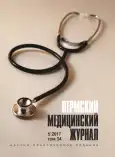REPEATED ARVI AND NUTRITION IN PRESCHOOL CHILDREN- ARE THEY INTERCONNECTED?
- Authors: Startseva SE1, Krasavina NA2
-
Affiliations:
- Пермская краевая клиническая больница
- Пермский государственный медицинский университет им. академика Е.А. Вагнера
- Issue: Vol 34, No 5 (2017)
- Pages: 95-101
- Section: Articles
- URL: https://journals.rcsi.science/PMJ/article/view/7287
- DOI: https://doi.org/10.17816/pmj34595-101
- ID: 7287
Cite item
Full Text
Abstract
Keywords
Full Text
##article.viewOnOriginalSite##About the authors
S E Startseva
Пермская краевая клиническая больница
Email: starceva_3691@mail.ru
врач - пульмонолог 614066, г. Пермь, ул. Баумана, 17А
N A Krasavina
Пермский государственный медицинский университет им. академика Е.А. Вагнерадоктор медицинских наук, профессор, доцент кафедры педиатрии ФДПО 614000, г. Пермь, ул. Петропавловская, 26
References
- Волкова Л.Ю. Алиментарные факторы формирования костной ткани у детей и подростков. Пути профилактики возможных нарушений. Вопросы современной педиатрии 2015; 14 (1): 124-131.
- Здравоохранение России. Федеральная служба государственной статистики 2015; 174.
- Красавина Н.А., Старцева С.Е. Питание детей дошкольного возраста с повторными ОРВИ. Актуальные вопросы педиатрии: материалы межрегиональной научно-практической конференции с международным участием. Пермь 2016; 151.
- О состоянии санитарно-эпидемиологического благополучия населения в Российской Федерации в 2014 году: государственный доклад. М.: Федеральная служба по надзору в сфере защиты прав потребителей и благополучия человека 2015; 206.
- Полунина Н.В., Павлова С.В., Полунина В.В. Формирование здоровья длительно и часто болеющих детей с социально-гигиенических позиций. Сестринское дело 2008; 3: 5-7.
- Радциг Е.Ю. Современные комплексные гомеопатические препараты для профилактики и лечения острых респираторных инфекций и гриппа у детей. Педиатрия 2013; 92(2): 120-126.
- Старцева С.Е., Красавина Н.А. Питание семьи в выходные дни в зависимости от индекса резистентности. Актуальные вопросы педиатрии: материалы межрегиональной научно-практической конференции с международным участием. Пермь 2017; 295.
- Antigenic and genetic characteristics of influenza A (H5N1) and influenza A (H9N2) viruses and candidate vaccine viruses developed for potential use in human vaccines. Global Alert and Response (GAR). Geneva, WHO 2010, available at: http://www.who.int/influenza/ resources/documents/201009_H5_H9_VaccineVirusUpdate.pdf
- Global Influenza Surveillance Network. Contribute to reducing death and disease due to annual influenza epidemics and prepare for the next influenza pandemic. Global Alert and Response (GAR). WHO 2011.
- Meeting of the WHO working group on polymerase chain reaction protocols for detecting subtype influenza A viruses. Geneva, June 2010. Weekly Epidemiological Record (WER) 2010; 85(46): 453-460.
Supplementary files






